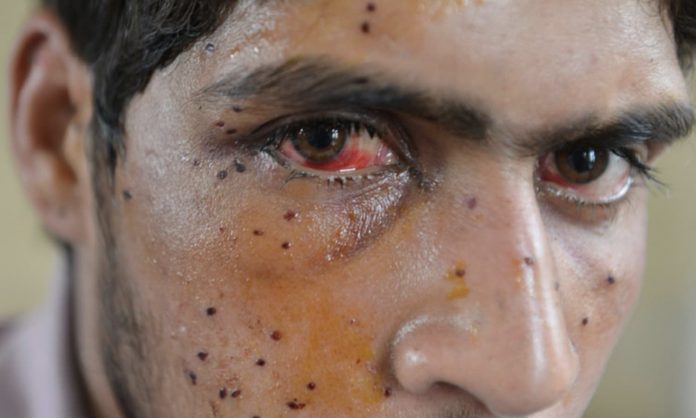The study examined 777 patients diagnosed with pellet gun-related injuries admitted to the tertiary hospital in Srinagar, between July and November 2016.
Auqib Javeed | TwoCircles.net
SRINAGAR (JAMMU AND KASHMIR) — While strongly advising the use of pellet guns against the civilians in Kashmir, India’s top retina surgeon Prof. Dr S. Natarajan has observed that over 80% of 777 pellet gun victims in Jammu & Kashmir have suffered partial vision loss.
This was revealed by a study published in the Indian Journal of Ophthalmology, a publication of All India Ophthalmological Society and Dr S Natrajan is one of the main authors of the paper.
For a decade, the security forces in the valley have extensively used shotgun pellets to subdue protesters, many of them young men and teenagers.
The pellets have caused thousands of injuries, including loss of eyesight. It was introduced as an ostensibly “non-lethal” option for crowd control, to replace live ammunition. However, it turned more deadly.
The forces used pellet guns during the mass uprising in 2010 and 2016.
Because of the poor health infrastructure, Dr S Natrajan travelled to Srinagar five times in 2016 to operate on those injured by pellets, along with a doctor each from New Delhi and Chennai.
He observed that the poor visual outcomes, high costs of medical care, and long‐term visual rehabilitation process in these young working‐age patients impose a significant physical, emotional, and socio‐economic burden on both individuals and society.
“Therefore, prevention is always better than the cure in ophthalmic trauma, and it is strongly advised to avoid the use of pellet guns against civilians,” the study noted.
Dr S Natrajan said that the team established their camp at the Shri Maharaja Hari Singh (SMHS) hospital in Srinagar and they found out that almost 210 casualties with eye injuries caused by pellet guns were clamouring to receive treatment.
“The local doctors had undertaken primary repair in 184 cases to restore the anatomy but a large number of them required the removal of pellets lodged inside the eye,” he says in the study, a copy of which lies with TwoCircles.net.
He further said that these victims of pellet injuries were young, many in their teens. “They had an entire life ahead of them. The heart‐breaking sight of children as young as 10 on the hospital beds moved me to my core. These injuries were going to permanently change their lives forever,” he noted.
The study examined 777 patients diagnosed with pellet gun-related injuries admitted to the tertiary hospital in Srinagar, between July and November 2016.
“The intensive period of unrest resulted in an overwhelming number of ocular injuries—three surgeons managed more than 777 patients, conducted more than 550 primary ocular repairs, and performed more than 370 vitreoretinal surgeries,” the study revealed.
The study noted that a previous case series reported that not just the eye, but also the brain, head, and neck were the most common sites of injury caused by ball‐bearing and pellet weapons.
“Although the study focused on ocular pellet injuries, it should be noted that given the nature of the mechanism of injury, patients may require concurrent management of injuries to other parts of the body, which may be life‐threatening.” It said, adding that “Therefore, the management of pellet gun injuries may require the involvement of neurosurgeons, otorhinolaryngologists, and other surgical specialists,”
It may be noted that from time to time various national and international human rights groups have called on India to end the use of pellets against civilians in Kashmir.
In 2020, global watchdog Human Rights Watch (HRW) accused Indian forces of “maiming, blinding, and killing people” in Kashmir as they continue to defy international norms by using pellet guns as a means of crowd control.
“Time and again, Indian law enforcement’s use of [pellet] shotguns in Kashmir has resulted in shocking, grievous injuries of protesters and bystanders,” Meenakshi Ganguly, South Asia director at HRW, said in a statement.
In June 2021, United Nations Secretary-General Antonio Guterres expressed concern over “grave violations” in Kashmir and asked the Indian government to end the use of shotgun pellets against children.
According to a report, the pellet guns have killed 24 and blinded 139 in Kashmir since 2010.
Presently, in 2020, the Jammu and Kashmir High Court refused to ban the use of pellet guns for crowd control, stating that “the use of pellets was inevitable as long as there is violence by an unruly mob.”
Auqib Javeed is a journalist based in Kashmir. He tweets @AuqibJaveed

